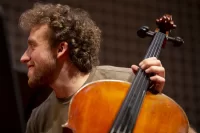
Gloom and misery begone? Statistics gets a major makeover from a student-professor team
It is hard to teach statistics.
“It’s hard to learn, too,” says psychology major Margaret Foster ’15 of York, Maine.
It’s a staple of the social sciences, yet learning stats has bedeviled generations of college students. At Bates, professors have tried to do something about it.
In the 1970s, Bates psychologist Drake Bradley responded to the call to improve the teaching of statistics by using an innovative tool — the computer — to teach the ins and outs of data sets. He published a paper on it: “An interactive data-generating and answer-correcting system for problems in statistics.”
Today, Professor of Psychology Amy Douglass is using her own innovative strategy.
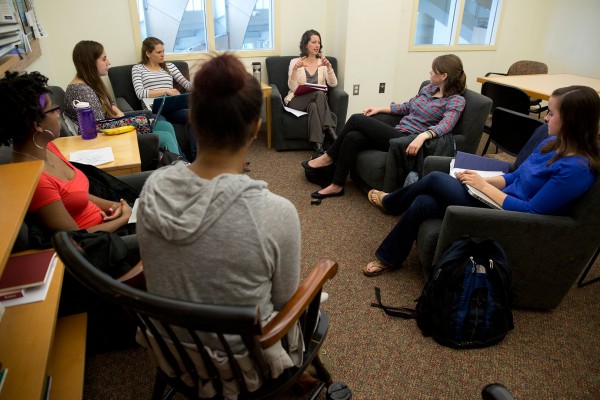
Professor of Psychology Amy Douglass gathers her six-student team at the start of Short Term. Their goal: to transform how statistics is taught at Bates. (Phyllis Graber Jensen/Bates College)
Despite tweaks to the Bates statistics course over the years, Douglass says that many students still have a hard time.
“If the course is ever going to appeal to students who are less comfortable with statistics, I need to understand the student experience,” she says.
So Douglass took advantage of a distinctive new Bates program offered this Short Term.
“We’re all about a continuous process of renewal.”
Called “Innovative Pedagogy / Course (Re)Design,” the program gives faculty the time and support (in this case, Bates students) to rework an existing course or create a new one.
It’s highly unusual in American higher education: On a wide scale, Bates is giving students the lead in improving how college courses are designed, deployed and taught.
Douglass enlisted six students, including Foster, to improve the Bates statistics course, Psychology 218, and theirs was one of five Short Term courses whose goal was either to create a new course or improve an old one.
For the college, the course redesign program means that “we’re all about a continuous process of renewal,” says President Clayton Spencer. The new and revised courses “create new oxygen for the curriculum.”
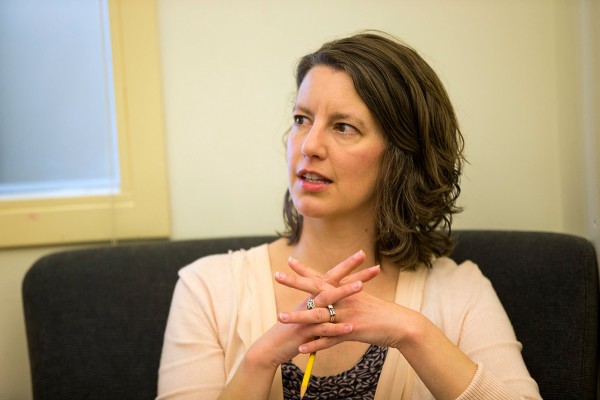
“If the course is ever going to appeal to students who are less comfortable with statistics, I need to understand the student experience,” says Professor of Psychology Amy Douglass. (Phyllis Graber Jensen/Bates College)
This spring, “Team Douglass” comprised Foster, Afifa Avril ’15 of Decatur, Ga., Kelsey Berry ’15 of Hollis, N.H., Eleanor Hough ’16 of Summit, N.J., Patrece Joseph ’14 of Mattapan, Mass., and Nina Tupper ’14 of Kennebunk, Maine.
They did their work by reviewing current best practices, reading literature and doing a survey of students who had taken statistics.
Meeting four days a week with Douglass, the students also spent time outside class on various projects, from evaluating the effectiveness of quizzes to looking at how papers should be assigned.
Among other things, they learned from the survey that not one of 50 students surveyed felt that the textbook was at all helpful. On the other hand, every student said the weekly review sessions offered by Brian Pfohl, the department’s assistant in instruction, were “very helpful.”
By next winter, students who take statistics — required for the 70 or so majors who graduate in psychology or neuroscience each year — will experience a revised course that has student fingerprints all over it.
Here’s a general idea of how the course was formerly structured:
- The class met three times a week
- Weekly quiz on Mondays
- Optional weekly review session on Friday afternoon
- Four papers, known as “demonstration reports”
- Cumulative final exam
And here’s an overview of the changes coming:
We don’t need no stinkin’ texbooks!
Much maligned by students for being dense and redundant, the statistics textbook is now gone from the syllabus. (At the very least, it will save students $130!)
Watch and learn
Next year, students will be asked to watch videos outside of class to help them master “hand calculations.” That’s the ability to do rough statistics calculations on your own.
“Being able to do hand calculations helps students understand what’s happening in the statistics software,” explains Patrece Joseph.
Hand calculations are lengthy and complicated. “Because students vary in how quickly they master them, the videos allow students to move at their own pace outside of class,” Douglass says.
More exams?
Instead of just one exam, the final, students will take three additional exams within the semester, each one testing students on material in one of the prior units.
True, adding exams increases the workload. “But we feel students need cumulative test experience before they take the final,” says Nina Tupper.
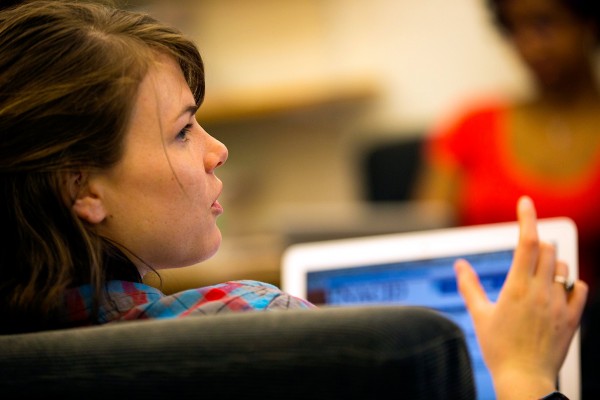
Adding more exams to the syllabus should help in the long run, says Nina Tupper ’14 of Kennebunk, Maine. (Phyllis Graber Jensen/Bates College)
No more Monday quizzes
The weekly quizzes will be on Friday from now on, and they’ll be at the beginning of class, not the end.
Having the quiz on Monday meant students boned up on Sunday, when there’s not a lot of academic support if they get stuck.
Giving a quiz at the end of class is when students aren’t at their best. Their brains are jumbled, the day’s new information competing with what they need to recall for the quiz.
Thank God it’s (not) Friday
Having optional review sessions on a Friday afternoon was difficult for student who had already spent an hour and 20 minutes in a lecture. “It’s hard to stay focused on statistics for three hours on a Friday afternoon,” says Kelsey Berry. They’ll be on Wednesday afternoons now.
Unit of measurement
To give the course more of a real-world feel, Douglass and her students have organized the class into four units: Health Psychology, Social Psychology, Psychology and Law, and Parenting and Families.
“We had units before, but they were week-to-week and perhaps not as cohesive,” Douglass says. “They will allow students to explore their interests while applying statistical knowledge.”
Speak now
When a professor teaches new ideas and new content right up until the last day of the semester, students don’t always learn well. But they do stress out.
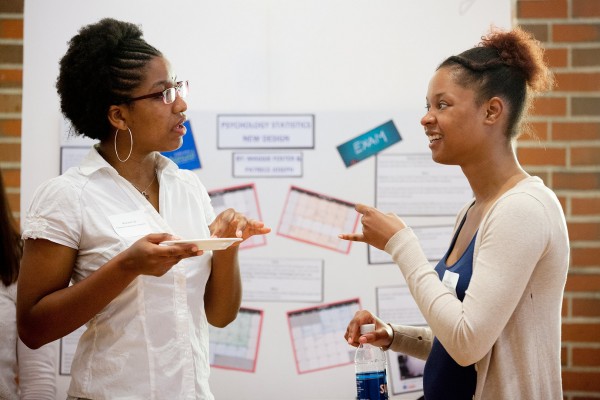
Afifa Avril ’15 and Patrece Joseph ’14 talk at a campus event on May 15 where students from various Short Term courses made poster presentations. (Phyllis Graber Jensen/Bates College)
This winter, the statistics course will instead conclude with student presentations. “They’ll analyze a dataset, and talk about what they’ve learned,” says Eleanor Hough.
“Preparing an oral presentation makes a student think about the material in different ways,” says Afifa Avril. “It also doubles as a way for students to review material for the final”
Demo reports done differently
The course asks students to write demonstration reports in American Psychological Association style, meaning they needed four parts: Introduction, Methods, Results and Discussion.
In addition, they write two appendixes, one for hand calculations and one that explains statistical concepts to a lay audience.
“We decided to eliminate two writing-intensive parts of the reports, the Introduction and Discussion,” Douglass says, “so students can focus more on the conceptual content of an APA-style report.”
It’s a sensible move. Learning to write an APA-style Introduction and Discussion is already taught in two required methods courses, Psychology 261 (“Research Methods”) and Psychology 262 (“Community-Based Research Methods”).
Pssst! SPSS Analyses!
Last year, students were required to do brief, outside-of-class analyses using a software known as
SPSS (Statistical Package for the Social Sciences).
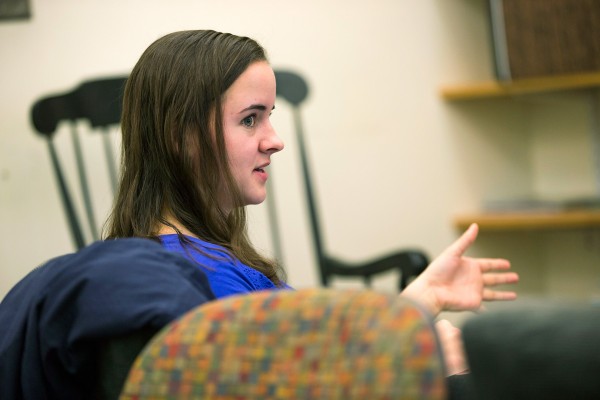
Next year, students will do their statistical software analyses during class time, explains Margaret Foster. (Phyllis Graber Jensen/Bates College)
Next year, students will do SPSS analyses in class. They’ll be harder, and will use student-designed worksheets. “Importantly, the worksheets will assume that students watched the videos about hand calculations,” says Douglass.
Meaning that when students come to class to do an SPSS analysis, they will (or should) be ready to roll.
“Moving the SPSS analyses into the class time will allow students to learn more about manipulating the numbers in a problem,” explains Foster.
“It’s like they’re paying it forward.”
Looking back on the experience with her students, Douglass says two things struck her: her students’ creative approaches to solving problems, and their abiding interest in making the course better for the next generation of students.
“Even though they’re done with it, they really care about making it better for the next cohort,” Douglass says. “It’s like they’re paying it forward.”
